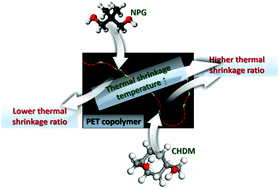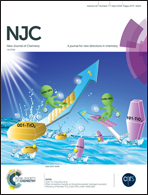Effects of thermal shrinkage temperatures and comonomers on thermal shrinkage of uniaxially-stretched PET copolymer films: a molecular dynamics simulation approach†
Abstract
A molecular dynamics simulation method was employed to investigate the effects of thermal shrinkage temperatures and comonomers on the thermal shrinkage of a uniaxially stretched PET copolymer model. Our investigation draws three primary conclusions. First, the thermal shrinkage ratio of the PET copolymer would strongly depend on the thermal shrinkage temperature, showing that the thermal shrinkage ratio is proportional to the thermal shrinkage temperature. It is inferred that the thermal shrinkage temperature provides kinetic energy to overcome the activation energy barrier for the molecular relaxation of the stretched polymer chains. Second, the introduction of a bulky comonomer limits the conformational rearrangement of the PET copolymer chain during the uniaxial stretching process owing to the limited chain flexibility. Therefore, it is confirmed that the thermal shrinkage can be tuned as a function of process conditions and comonomer type. Third, our analysis on the PET copolymer film at molecular levels further verifies that the trans–gauche transformation in the polymer backbone is the main factor for the thermal shrinkage of uniaxially stretched PET copolymer systems.



 Please wait while we load your content...
Please wait while we load your content...